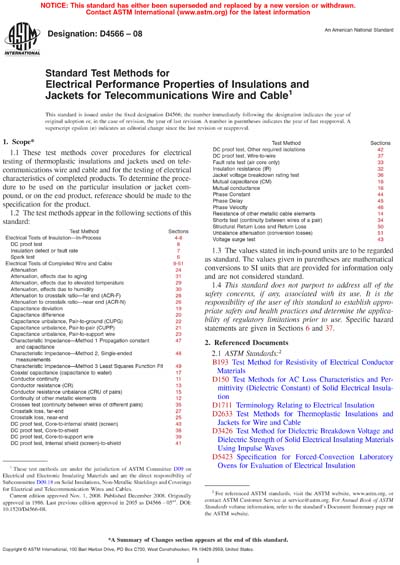Historical
ASTM D4566-08
Standard Test Methods for Electrical Performance Properties of Insulations and Jackets for Telecommunications Wire and Cable
1.1 These test methods cover procedures for electrical testing of thermoplastic insulations and jackets used on telecommunications wire and cable and for the testing of electrical characteristics of completed products. To determine the procedure to be used on the particular insulation or jacket compound, or on the end product, reference should be made to the specification for the product.
1.2 The test methods appear in the following sections of this standard:
| Test Method | Sections |
|---|---|
| Electrical Tests of Insulation—In-Process | 4-8 |
| DC proof test | 8 |
| Insulation defect or fault rate | 7 |
| Spark test | 6 |
| Electrical Tests of Completed Wire and Cable | 9-51 |
| Attenuation | 24 |
| Attenuation, effects due to aging | 31 |
| Attenuation, effects due to elevated temperature | 29 |
| Attenuation, effects due to humidity | 30 |
| Attenuation to crosstalk ratio—far end (ACR-F) | 28 |
| Attenuation to crosstalk ratio—near end (ACR-N) | 26 |
| Capacitance deviation | 19 |
| Capacitance difference | 20 |
| Capacitance unbalance, Pair-to-ground (CUPG) | 22 |
| Capacitance unbalance, Pair-to-pair (CUPP) | 21 |
| Capacitance unbalance, Pair-to-support wire | 23 |
| Characteristic Impedance—Method 1 Propagation constant and capacitance | 47 |
| Characteristic Impedance—Method 2, Single-ended measurements | 48 |
| Characteristic Impedance—Method 3 Least Squares Function Fit | 49 |
| Coaxial capacitance (capacitance to water) | 17 |
| Conductor continuity | 11 |
| Conductor resistance (CR) | 13 |
| Conductor resistance unbalance (CRU of pairs) | 15 |
| Continuity of other metallic elements | 12 |
| Crosses test (continuity between wires of different pairs) | 35 |
| Crosstalk loss, far-end | 27 |
| Crosstalk loss, near-end | 25 |
| DC proof test, Core-to-internal shield (screen) | 40 |
| DC proof test, Core-to-shield | 38 |
| DC proof test, Core-to-support wire | 39 |
| DC proof test, Internal shield (screen)-to-shield | 41 |
| DC proof test, Other required isolations | 42 |
| DC proof test, Wire-to-wire | 37 |
| Fault rate test (air core only) | 33 |
| Insulation resistance (IR) | 32 |
| Jacket voltage breakdown rating test | 36 |
| Mutual capacitance (CM) | 18 |
| Mutual conductance | 16 |
| Phase Constant | 44 |
| Phase Delay | 45 |
| Phase Velocity | 46 |
| Resistance of other metallic cable elements | 14 |
| Shorts test (continuity between wires of a pair) | 34 |
| Structural Return Loss and Return Loss | 50 |
| Unbalance attenuation (conversion losses) | 51 |
| Voltage surge test | 43 |
1.3 The values stated in inch-pound units are to be regarded as standard. The values given in parentheses are mathematical conversions to SI units that are provided for information only and are not considered standard.
1.4 This standard does not purport to address all of the safety concerns, if any, associated with its use. It is the responsibility of the user of this standard to establish appropriate safety and health practices and determine the applicability of regulatory limitations prior to use. Specific hazard statements are given in Sections 6 and 37. 4.1 In-process electrical tests are used primarily as process control tools in an attempt to minimize the number and magnitude of problems detected at final test of completed cable. 9.1 Electrical tests of completed wire and cable may include verification of some or all of the properties in accordance with Sections 11 through 51.
ASTM International [astm]

